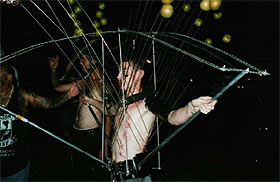Crossbow Piercing and Cultural appropriation: Difference between pages
(Page conversion via llm-mediawiki-rev -jwm) |
(Page conversion via llm-mediawiki-rev -jwm) |
||
| Line 1: | Line 1: | ||
[[File:CulturalAppropriation.jpg|link=File:CulturalAppropriation.jpg|right|280px]] | |||
[[File:O-Kee-Pa-4.jpg|thumb|right|150px|O-Kee-Pa]] | |||
'''Cultural appropriation''' is adopting of icons, [[Ritual|rituals]], aesthetic standards, and behavior from one culture or subculture by another, generally by a "modern" culture from a "primitive" culture. This appropriation often occurs without any real understanding of why the original culture took part in these activities or the meanings behind these activities, converting [[Religion|religion]] and [[Spirituality|spirituality]] into "meaningless" pop-culture. Some people have suggested rituals such as [[Kavadi|kavadi]] and [[O-Kee-Pa|O-Kee-Pa]] [[Suspension|suspensions]] are callous cultural appropriation. | |||
As a note, this article is not an attack or insult towards those with these mods. | |||
Simply it is to illustrate that these are sensitive issues and if you're going to borrow or even just draw inspiration from another culture you should educate yourself thoroughly to avoid stepping on toes. | |||
== Suspension == | |||
It has been argued that suspension not only steals from the [[Tribal|tribal]] cultures that "developed" them but also defiles that culture because it reduces them to an act without the spiritual framework they were "designed for." That said, others hold that suspension is a tool that can be used for many purposes and one that has been explored by numerous cultures. No culture can "patent" suspension and ask others not to be involved with it. As such, the real question would be, is suspension a cultural misappropriation? | |||
Suspension itself—the physical act of hooks through flesh suspending a body—has very little cultural meaning. The meaning comes from the ritual and philosophies surrounding it. We can use suspension but it is our job to come up with our own meaning. As most of us are neither [[Native American|Native American]] nor [[Hindu|Hindu]], we cannot reasonably understand the nuances of their rituals and by attempting to replicate, them we produce at best a shallow copy that insults everyone involved. | |||
It should be noted that, while the above is what most people feel, there are others who point out that cultures are constantly borrowing from each other. They feel that as long as we respect the cultures we appropriate from that we have every right to assimilate their rituals. | |||
== | == Iconography == | ||
A more common sort of cultural appropriation in the body modification world is borrowing the iconography of another culture. Obvious examples includes tattoos of [[Hindu|Hindu]] gods, [[Polynesian|Polynesian]] tribal iconography, or even [[Kanji|Kanji]] tattoos by white people from America who have no real understanding of the meanings behind these symbols. By turning them into nothing more than "something that looks cool" they not only make themselves look foolish but offer a slap in the face the group they stole from. | |||
Latest revision as of 02:10, 17 September 2023
Cultural appropriation is adopting of icons, rituals, aesthetic standards, and behavior from one culture or subculture by another, generally by a "modern" culture from a "primitive" culture. This appropriation often occurs without any real understanding of why the original culture took part in these activities or the meanings behind these activities, converting religion and spirituality into "meaningless" pop-culture. Some people have suggested rituals such as kavadi and O-Kee-Pa suspensions are callous cultural appropriation.
As a note, this article is not an attack or insult towards those with these mods. Simply it is to illustrate that these are sensitive issues and if you're going to borrow or even just draw inspiration from another culture you should educate yourself thoroughly to avoid stepping on toes.
Suspension
It has been argued that suspension not only steals from the tribal cultures that "developed" them but also defiles that culture because it reduces them to an act without the spiritual framework they were "designed for." That said, others hold that suspension is a tool that can be used for many purposes and one that has been explored by numerous cultures. No culture can "patent" suspension and ask others not to be involved with it. As such, the real question would be, is suspension a cultural misappropriation?
Suspension itself—the physical act of hooks through flesh suspending a body—has very little cultural meaning. The meaning comes from the ritual and philosophies surrounding it. We can use suspension but it is our job to come up with our own meaning. As most of us are neither Native American nor Hindu, we cannot reasonably understand the nuances of their rituals and by attempting to replicate, them we produce at best a shallow copy that insults everyone involved.
It should be noted that, while the above is what most people feel, there are others who point out that cultures are constantly borrowing from each other. They feel that as long as we respect the cultures we appropriate from that we have every right to assimilate their rituals.
Iconography
A more common sort of cultural appropriation in the body modification world is borrowing the iconography of another culture. Obvious examples includes tattoos of Hindu gods, Polynesian tribal iconography, or even Kanji tattoos by white people from America who have no real understanding of the meanings behind these symbols. By turning them into nothing more than "something that looks cool" they not only make themselves look foolish but offer a slap in the face the group they stole from.

